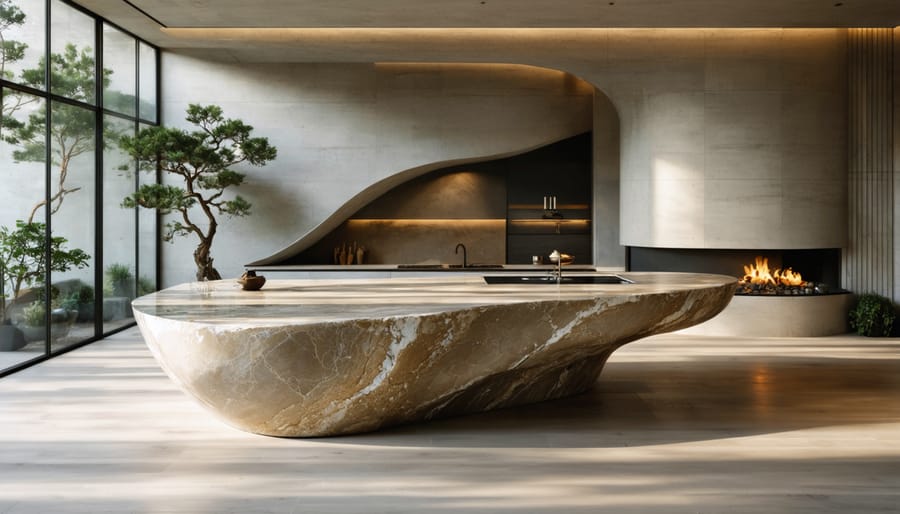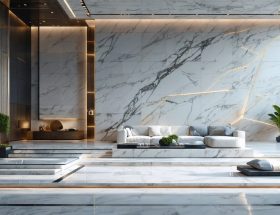Modern organic style represents the evolution of design thinking—where the raw, tactile beauty of natural materials meets the clean sophistication of contemporary architecture. This emerging aesthetic abandons rigid geometries in favor of flowing, curved forms that echo patterns found in nature, particularly through the sculptural use of stone. Curved stone applications—from sweeping kitchen islands and arched doorways to rounded fireplace surrounds and wavelike bathroom walls—create spaces that feel both grounded and ethereal, balancing minimalist principles with warmth and sensory richness.
The appeal extends beyond aesthetics. Stone’s inherent durability and timelessness align perfectly with sustainable design values, while modern fabrication technologies now allow for precisely engineered curves that were once prohibitively expensive or technically challenging. For homeowners seeking refuge from sterile, angular interiors, and for designers pushing beyond predictable trends, curved stone elements offer a distinctive signature—one that transforms functional surfaces into organic sculptures. This approach doesn’t simply decorate spaces; it fundamentally reshapes how we experience our built environments, creating fluid transitions that invite touch, soften acoustics, and establish a profound connection between interior sanctuaries and the natural world beyond.
What Defines Modern Organic Style
The Marriage of Natural Materials and Contemporary Aesthetics
Modern organic style represents a thoughtful convergence where the untamed beauty of nature meets the precision of contemporary architecture. This design philosophy embraces natural stone textures—with their inherent variations, fossils, and mineral deposits—while incorporating them into spaces defined by clean lines and intentional simplicity.
The key to achieving this balance lies in allowing stone to be both the focal point and a supporting element. Rather than overwhelming a space with ornate details, modern organic design lets the material’s authentic character shine through strategic placement and minimal intervention. A single slab of veined marble becomes a statement wall, its raw beauty amplified by surrounding neutral tones and uncluttered surfaces.
Contemporary design elements like geometric forms, floating vanities, and seamless edges provide the structure that grounds organic materials. The juxtaposition creates visual tension: rough-hewn travertine paired with polished metal fixtures, or honed limestone countertops set against sleek cabinetry. This interplay prevents spaces from feeling either too sterile or overly rustic.
The sophistication emerges from restraint. By limiting color palettes to earth tones and neutrals, and selecting stones with subtle rather than dramatic veining, designers create environments that feel both timeless and current. The result is a space where occupants experience the calming presence of natural materials without sacrificing the functionality and visual clarity that define modern living.
The Psychology Behind Curved Stone Elements
Our brains are hardwired to respond positively to curves and organic shapes. Research in environmental psychology reveals that angular, sharp-edged spaces can trigger subtle stress responses, while curved forms activate pleasure centers in our brains and promote feelings of safety and comfort. This biological preference stems from our evolutionary past, where flowing water, smooth river stones, and rounded natural formations signaled hospitable, safe environments.
When traditionally hard, imposing materials like granite, marble, or limestone are shaped into curves, something transformative occurs. The inherent weight and permanence of stone—qualities that might feel cold or austere in rectilinear applications—become inviting and human-scaled through curved design. A sweeping stone countertop edge or a rounded peninsula physically guides movement through space, creating intuitive pathways that feel natural rather than forced.
The psychological impact extends beyond aesthetics. Curved stone elements eliminate visual interruptions that sharp corners create, allowing the eye to flow continuously through a room. This visual continuity reduces cognitive load, the mental effort required to process our surroundings, resulting in spaces that feel inherently calming. The tactile experience matters too—running your hand along a curved stone surface provides a sensory connection to both the material’s geological history and the craftsmanship that shaped it.
Nature rarely produces straight lines, favoring instead the gentle erosion patterns visible in weathered rock faces, the rounded contours of beach pebbles, and the organic forms of caves. By incorporating curved stone elements into interior spaces, designers tap into biophilic design principles—our innate need to connect with natural patterns. The result is environments that don’t just look beautiful but actively contribute to occupant wellbeing and stress reduction.
Curved Stone Applications That Define Organic Fluidity
Flowing Kitchen Islands and Countertops
The kitchen becomes a sculptural centerpiece when organic curves replace traditional straight edges. Flowing kitchen islands with serpentine contours create natural gathering points while softening the hard lines typically found in culinary spaces. These graceful forms pair beautifully with waterfall edge countertops, where stone cascades seamlessly from horizontal surfaces to the floor, eliminating visual breaks and emphasizing the material’s natural beauty.
Curved breakfast bars extend this fluid aesthetic, wrapping around islands or peninsulas to create intimate dining experiences. The rounded edges not only enhance visual appeal but also improve functionality by eliminating sharp corners and creating more comfortable interaction zones.
**Optimal Stone Selections**
Marble remains the quintessential choice for organic kitchen designs, with varieties like Calacatta and Statuario offering dramatic veining that follows curved lines naturally. The stone’s inherent elegance complements the flowing forms perfectly.
Quartzite provides similar aesthetic appeal with superior durability, resisting etching and heat better than marble—essential qualities for high-use kitchen surfaces. White and light-colored quartzites with subtle veining work particularly well.
Granite offers the most practical option, combining durability with diverse pattern options. Leathered or honed finishes on granite enhance the organic aesthetic while providing excellent wear resistance.
**Fabrication Considerations**
Creating curved stone elements requires advanced fabrication expertise and CNC technology for precision cutting. Waterfall edges demand book-matched slabs to maintain pattern continuity around corners. Expect higher material waste and longer lead times compared to straight installations, typically adding 20-30% to project costs. Work with fabricators experienced in complex curved work to ensure structural integrity and seamless joints.
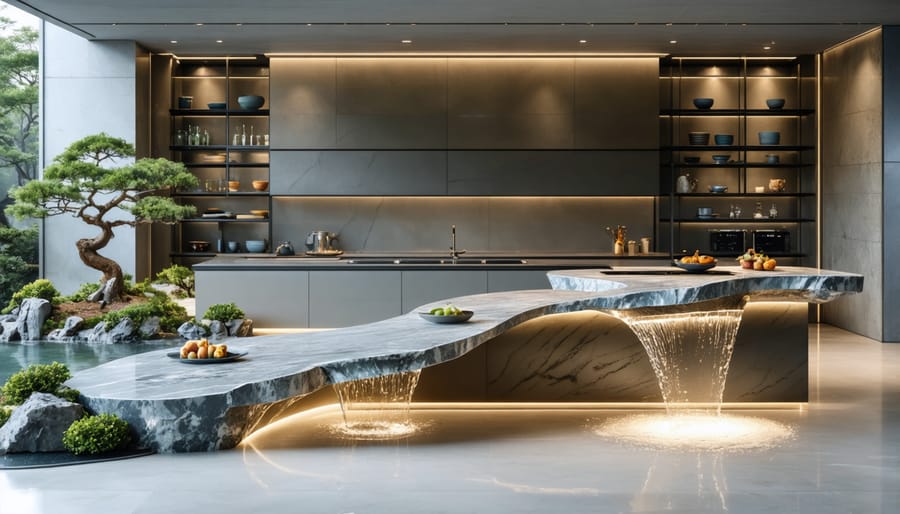
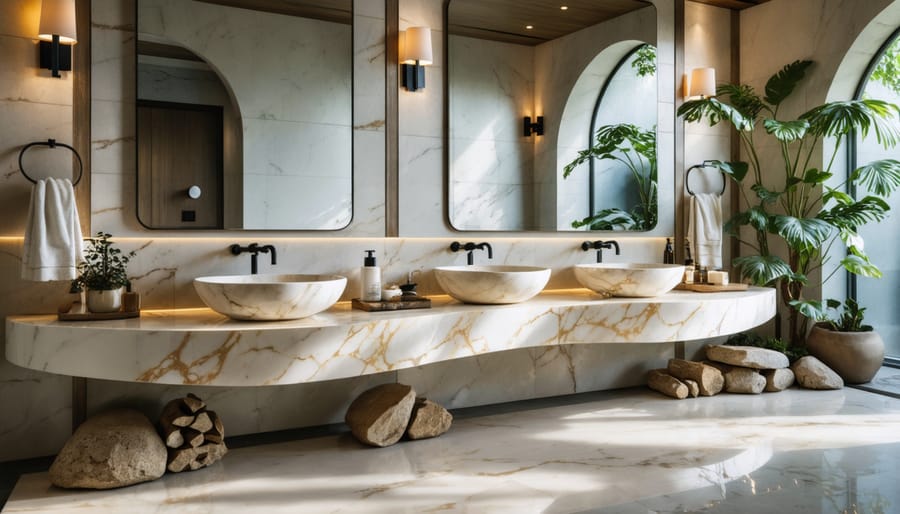
Sculptural Bathroom Features
Sculptural bathroom features represent the pinnacle of modern organic design, transforming functional spaces into spa-like sanctuaries through fluid stone forms. These statement pieces blur the line between utility and art, creating deeply relaxing environments that celebrate stone’s natural beauty.
**Curved Vanities and Organic Basins**
Contemporary stone vanities now feature sweeping curves rather than rigid angles, with countertops that flow seamlessly into backsplashes. Organic-shaped vessel sinks carved from single stone blocks—whether in onyx, marble, or limestone—serve as bathroom centerpieces. These free-form basins often retain natural edge details or incorporate subtle asymmetry that references water-worn stones.
**Sculptural Soaking Tubs**
Freestanding tubs carved from massive stone blocks epitomize luxury in modern organic bathrooms. Marble, travertine, and granite tubs feature rounded edges and ergonomic contours that cradle the body. While requiring significant structural support, these monolithic pieces create unforgettable focal points that age beautifully over decades.
**River-Rock Shower Floors**
Natural pebble tiles recreate the sensation of walking along riverbeds, providing textural massage underfoot while ensuring slip resistance. These rounded stones, available in colors from neutral tans to dramatic blacks, can be installed in organic patterns that enhance the bathroom’s natural aesthetic.
**Technical Considerations**
Working with curved stone elements requires skilled fabricators using CNC technology and water-jet cutting. Stone selection should prioritize water-resistant varieties with low porosity. Proper sealing is essential for all bathroom stone applications, particularly in wet areas where moisture exposure is constant. Professional installation ensures structural integrity and proper drainage integration.
Architectural Stone Walls and Partitions
Stone walls and partitions serve as sculptural elements that define space while maintaining visual connectivity—a hallmark of modern organic design. Unlike traditional straight partitions, these architectural features incorporate fluid curves and natural irregularities that echo forms found in nature.
Undulating stone feature walls create dramatic focal points in residential and commercial spaces. These installations use book-matched stone panels arranged in wave-like patterns, with each panel carefully sequenced to maintain visual continuity across the surface. The three-dimensional quality becomes particularly striking when sidelighting emphasizes the depth and texture variations.
Curved room dividers offer functional separation without sacrificing openness. Fabricated from thinner stone panels (typically 10-20mm) with honeycomb backing for structural support, these freestanding partitions can be shaped into gentle arcs or more dramatic serpentine forms. They’re especially effective in open-plan living areas, where they create zones while allowing light and sightlines to flow through the space.
Wave-pattern stone cladding applies organic principles to vertical surfaces through repetitive, rhythmic designs. This approach works particularly well with stones featuring linear veining—such as certain marbles or quartzites—where the natural grain reinforces the undulating pattern. Advanced CNC technology enables precise cutting of these complex geometries, making custom curved installations more accessible than ever before.
Curved Stone Furniture and Accent Pieces
Stone furniture pieces blur the line between functional design and sculptural art, serving as focal points that anchor modern organic interiors. Organically-shaped coffee tables with fluid, asymmetrical edges bring tactile beauty to living spaces, with materials like honed marble or limestone offering smooth surfaces perfect for everyday use. These statement pieces often feature live-edge inspiration, where the stone’s natural contours remain visible, celebrating rather than concealing the material’s origins.
Rounded side tables in travertine or onyx provide versatile accent pieces that soften angular room layouts. Their curved profiles complement the modern organic aesthetic while offering durability that wooden alternatives cannot match. The substantial weight of stone furniture also contributes to a sense of permanence and grounding in contemporary spaces.
Curved stone shelving introduces sculptural dimension to walls, with cantilevered designs appearing to float effortlessly. These installations work particularly well in powder rooms, entryways, or as display platforms for art objects. The inherent strength of stone allows for dramatic overhangs without visible support structures.
Sculptural seating elements, such as polished granite benches or carved limestone stools, function as functional art. While requiring careful consideration for comfort—often paired with cushions or textiles—these pieces make powerful design statements. Their monolithic presence creates conversation-starting moments while providing practical seating solutions that will endure for generations.
Exterior Applications: Bringing Curves Outside
Modern organic style transforms outdoor living spaces through flowing, nature-inspired stone elements that seamlessly integrate with surrounding landscapes. Curved stone pathways create inviting journeys through gardens, using natural flagstone or cut stone laid in sweeping arcs that feel intuitive rather than rigid. These walkways guide movement while softening the transition between built and natural environments.
Rounded retaining walls replace harsh linear barriers with gentle, sculptural forms that work with topography instead of against it. When constructed with stacked stone or precision-cut blocks, these curved walls add dimension and visual interest while providing essential structural support. The organic shapes blend naturally with plantings and terrain contours.
Pool areas benefit dramatically from organic-shaped coping that follows freeform designs rather than traditional rectangles. Limestone, travertine, or bluestone can be custom-cut to create flowing edges that mirror natural water features, while providing the durability needed for wet environments.
Outdoor kitchens embrace curved countertops and rounded island configurations that encourage gathering and conversation. Granite or quartzite surfaces shaped into gentle arcs create functional workspaces that feel cohesive with organic design principles, transforming utilitarian spaces into sculptural focal points that enhance outdoor entertaining.
Best Stone Types for Curved Organic Designs
Selecting the right stone for curved organic designs requires balancing aesthetic appeal with practical workability. Not all natural stones respond equally well to the demands of curved fabrication, and understanding these differences ensures both stunning results and long-term durability.
**Marble** stands out as the premier choice for curved applications. Its relatively soft composition allows fabricators to achieve smooth, flowing curves without excessive tool wear. Carrara and Calacatta varieties offer classic white backgrounds with dramatic veining that emphasizes curves beautifully. The stone’s translucency also creates subtle depth when backlit in curved installations. However, marble requires regular sealing and careful maintenance in high-traffic areas.
**Limestone** provides excellent workability for curved designs while offering a more understated aesthetic. Its uniform texture and matte finish create gentle, organic forms that feel grounded and natural. Limestone cuts cleanly along curves and accepts various finishes, from honed to brushed. It’s particularly suitable for interior applications like curved walls and fireplace surrounds, though its porosity demands protective sealing.
**Soapstone** delivers unmatched workability due to its talc content, making it ideal for tight radius curves and intricate organic shapes. Its natural dark gray tones deepen over time, creating rich patinas that enhance curved forms. Soapstone naturally resists staining and heat, requiring no sealing, which makes it practical for kitchen applications despite its softer surface.
**Travertine** offers unique textural qualities with its characteristic pitting and veining. While more brittle than marble, filled and honed travertine can achieve gentle curves effectively. Its warm earth tones complement organic design philosophies, particularly in spa-like bathroom settings.
**Granite**, while harder to work with curves, provides exceptional durability when gentle radii are acceptable. Modern fabrication technology has expanded granite’s curved applications, particularly for countertops with soft edge profiles. Leathered or honed finishes minimize the formal appearance, aligning better with organic aesthetics than polished surfaces.
The Fabrication Process: How Curves Are Created
Creating curved stone elements requires a sophisticated blend of advanced technology and artisan skill. Modern fabrication has evolved dramatically, making complex organic shapes not only achievable but precise and consistent.
**Computer Numerically Controlled (CNC) Technology**
CNC machines have revolutionized stone fabrication by translating digital designs into physical reality. These computer-guided tools can cut, shape, and carve stone with millimeter-level accuracy, creating smooth curves and intricate contours that would be nearly impossible by hand alone. The process begins with 3D modeling software, where designers perfect every curve before fabrication begins.
**Water Jet Cutting**
For particularly delicate curves or materials prone to stress fractures, water jet technology offers a heat-free cutting method. High-pressure water mixed with abrasive particles cuts through stone without introducing thermal stress, preserving the material’s structural integrity while achieving flowing, organic edges.
**The Role of Master Craftsmen**
Despite technological advances, skilled artisans remain essential to custom stone fabrication. Hand-finishing techniques refine machine-cut pieces, smoothing transitions and perfecting curves. Experienced fabricators assess each stone’s unique characteristics—veining, grain direction, and density—adjusting techniques accordingly to prevent cracking or chipping.
**Polishing and Finishing**
Achieving the sensuous surface quality that defines modern organic style requires multiple polishing stages. Diamond-embedded pads progressively refine the surface, moving from coarse to ultra-fine grits. For honed or textured finishes popular in organic designs, fabricators employ specialized brushing and flaming techniques that enhance the stone’s natural character while maintaining smooth, touchable curves.
This marriage of precision technology and human expertise enables the seemingly effortless curves that characterize modern organic stonework.
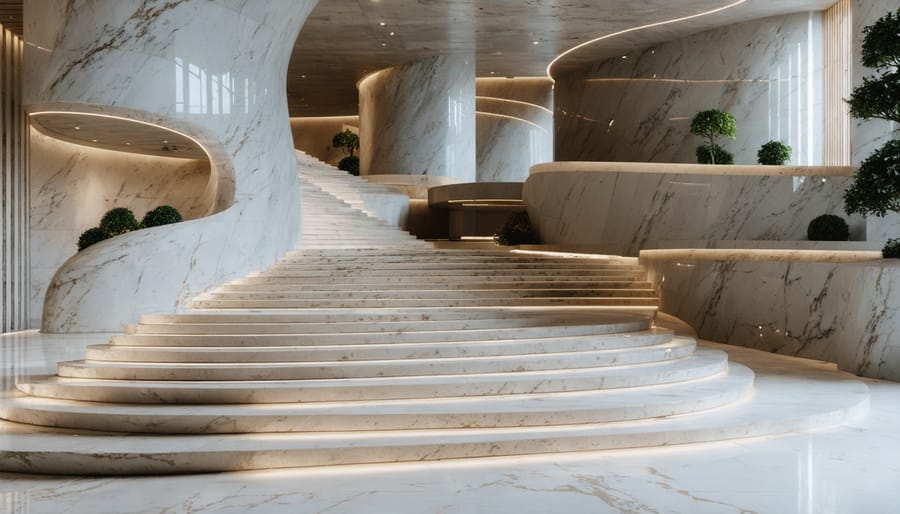
Design Considerations for Curved Stone Installations
Balancing Curves with Other Design Elements
The key to successful modern organic design lies in thoughtful contrast. Curved stone elements shine brightest when balanced against clean, straight architectural lines—think a flowing marble island paired with linear cabinetry or an undulating stone wall anchored by geometric windows. This interplay creates visual interest while maintaining the sophisticated restraint modern design demands.
When choosing complementary materials, consider textures that enhance rather than compete with your stone’s natural character. Warm woods soften stone’s coolness, while metals like brass or blackened steel provide contemporary edge. Matte finishes work particularly well alongside honed or brushed stone surfaces, creating a cohesive tactile experience.
Maintain visual harmony by limiting your curve vocabulary—if your stone features bold, dramatic waves, keep other curved elements more subtle. Similarly, vary the scale of curves throughout the space to avoid monotony. A sweeping stone backsplash might pair beautifully with smaller curved hardware or rounded furniture edges, creating rhythm without overwhelming the senses. Remember that negative space matters equally; allow your statement stone pieces room to breathe.
Cost and Investment Factors
Curved stone designs represent a significant investment compared to standard rectilinear applications, and understanding the cost factors helps set realistic expectations. The primary driver of increased expense is fabrication complexity—creating smooth, flowing curves requires specialized CNC machinery, skilled craftspeople, and considerably more production time than cutting straight edges.
Material waste is another consideration. Curved designs typically generate 15-30% more waste than rectangular cuts, as stones must often be cut from larger slabs to achieve the desired radius without visible seams. Premium materials like Calacatta marble or exotic quartzites already command higher prices, and waste factors compound these costs. Custom templating for curved installations also adds to project expenses, as precise measurements are essential for achieving seamless results.
Installation requirements further impact budgeting. Curved stone pieces are often heavier and more awkward to handle, requiring experienced installers and sometimes specialized equipment. The time investment for proper installation is typically 20-40% greater than comparable straight-edge projects.
However, these upfront costs deliver substantial long-term value. Curved stone designs create distinctive focal points that resist design trends, maintaining aesthetic appeal for decades. Natural stone’s durability means these installations often outlast multiple renovation cycles, effectively amortizing the initial investment over extended timeframes.
Quality fabrication from reputable stone suppliers ensures proper structural integrity and finish quality, reducing long-term maintenance costs. When positioned as a foundational design element rather than a trendy feature, curved stone installations represent an investment in timeless architectural character that enhances property value and daily living experience.
Curved stone designs represent more than a passing aesthetic trend—they signal a fundamental shift in how we conceive interior spaces. By embracing organic forms that mirror the natural world, these elements create environments that resonate with our innate need for connection to nature. The evolution toward softer, flowing lines in stone applications reflects a broader movement toward human-centric design that prioritizes wellbeing and comfort alongside visual appeal.
The accessibility of modern organic style through curved stone elements makes this approach viable for various project scales and budgets. Whether incorporating a single statement piece like an arched stone accent wall or undertaking a comprehensive design featuring curved countertops and flowing tile patterns, the impact on spatial quality is undeniable. Advanced fabrication technologies have made these once-challenging installations increasingly practical and cost-effective.
Taking the first step toward integrating curved stone into your space begins with consultation. Stone professionals can assess your project requirements, recommend appropriate materials, and provide technical guidance on fabrication and installation. Their expertise ensures your vision translates into durable, beautiful reality while maximizing the unique characteristics of natural stone. Embrace the modern organic movement and discover how curved stone designs can transform your interior into a sanctuary of natural elegance.

